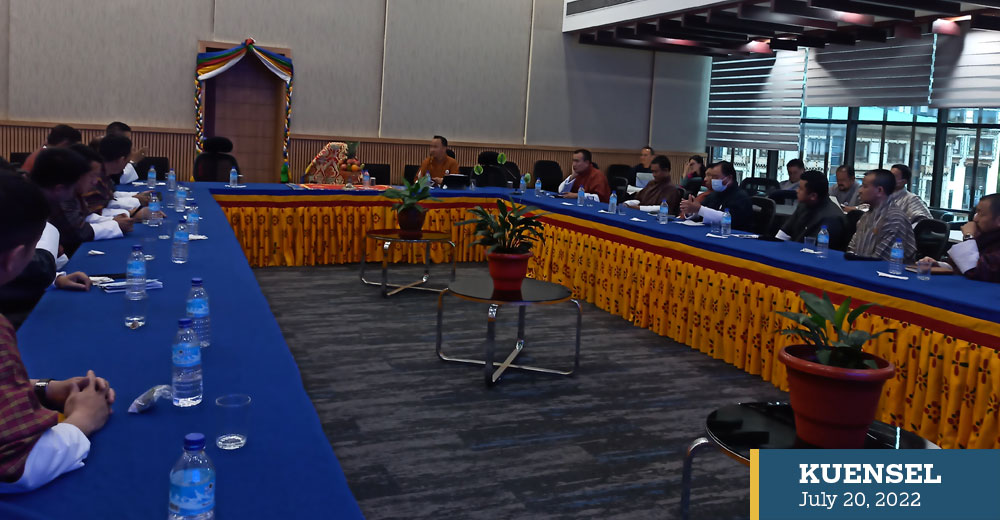Thukten Zangpo
The government’s discussion with the banks and the private sector on the monetary measures Phase IV is yet to arrive at a consensus.
Recently, the Royal Monetary Authority (RMA) announced Phase IV monetary measures offering loan deferments from one to two years and eight different forms of loan restructuring options depending on the risk category.
In the second round of the discussion held on July 18, the President of the Bhutan Chamber of Commerce and Industry, Tandy Wangchuk, sought clarification of the submissions of the first meeting.
Representing the private sector, he asked for blanket loan deferment and loan restructuring options across all the sectors rather than categorising based on high, moderate, and low risks.
Tandy Wangchuk said that micro, small and medium enterprises that were affected the most were not included in the recent monetary measures.
He also asked for bridging or soft loans for the hotels in the eastern and central regions because fewer tourists visit the region.
“If the submissions are not considered, many borrowers would land up in court,” Tandy Wangchuk said.
Finance Minister Namgay Tshering said the banks, government, and the private sector have to work together to ensure that the country’s economy succeeds with uniformity in the implementation of the monetary measures.
However, he said that the monetary measures are the prerogative of the RMA and the government can only facilitate them.
On deferring loan terms from two to five years, Lyonpo said that RMA had responded that the loan deferment period would be adopted with the evolving situation. “We would be in a better position to know the situation after two years.”
Similarly, on categorisation of loans, RMA stated that it would be reviewed based on the evolving situation. Lyonpo said that the ministry releases quarterly macroeconomic situations of the country along with the sectors’ performance.
Chairman of the Financial Institutions Association of Bhutan (FIAB), Karma, said that the central bank has full responsibility to maintain the stability of the economy through monetary policy, not based on the particular business or sector and that the banks are following the authority’s rules and regulations.
Karma said that the banks have instructed their team to discuss with every borrower based on their eligibility under the monetary measures.
However, the banks would also evaluate each client category on their ability to pay or not. For this, the RMA has given a time of about six months.
On new soft loans, Karma added that it would depend on how prepared the RMA relaxation is for the cash reserve ratio because the situation has changed.
Advisor to the Tashi Group of Companies, Chencho Thinley, said that repaying the bridge loans granted during the Covid-19 crisis to retailers to stock up on essentials and to industries that are trying to maintain the level of employment would be very difficult and harsh on companies.
As per the RMA, Lyonpo said that the work is in progress. However, Lyonpo said that grouping those who can pay and who cannot would be inconvenient.
Karma said that there is still room for discussion and there is also an option for the bridge loans to be converted to a fixed equated installment facility (FEIF) account.
FEIF accounts are created for the transfer of accumulated interest during the deferment period. Borrowers would be liable to pay the amount in the FEIF account in equal installments for a period of up to five years.
Chencho Thinley said that soft loans were released from the cash reserve ratio by the central bank. Therefore, it has zero cost other than the management cost. “To pay back in one shot is impossible.”
However, he said there is a danger of misusing the funds and needs a modality like FEIF with the monthly equated monthly installment, and if defaulted should be imposed a penalty.
Tandy Wangchuk also asked for the requirement of the collateral to fulfil the loan-to-value (LTV) ratio closer to the market value and harmonise the asset valuation.
Karma said that the concerns could be discussed and that the RMA is coming up with a valuation department.
Karma also said that the LTV ratio has not saved loans from going bad. “It is not necessary to be LTV that has bought the problem but it has been the loan to income or debt servicing,” he said, adding that 90 percent of non-performing loans (NPL) are because borrowers could not pay back.
Karma said that the banks also have to change the credit appraisal system and loan assessment must be accurate.
President of the Bhutan Exporters Association, Karma Tenzin, said that the monetary measures do not give concessions for NPL. “The bad loans also need to have deferment.”
Resolving NPL, Karma said, is not to fix the people but to fix the economy and enterprise management. “High NPL, in any economy, is damaging.”
Under viable and non-viable NPL, he said that a viable NPL has the option of restructuring measures, both administrative and financial. However, Karma said that the deferment of NPL would be a greater risk.
The chairman of the Horticulture Association of Bhutan, Tshering Wangchuk, said that the agriculture sector which did not perform during the pandemic has been categorised under low risk. He recommended it be categorised under high risk and provide a loan deferment of two years.
Lyonpo said that the government would closely follow the discussions and communicate to the private sectors through the associations.


